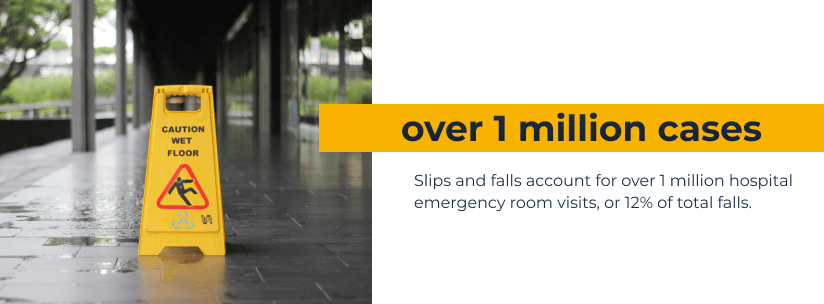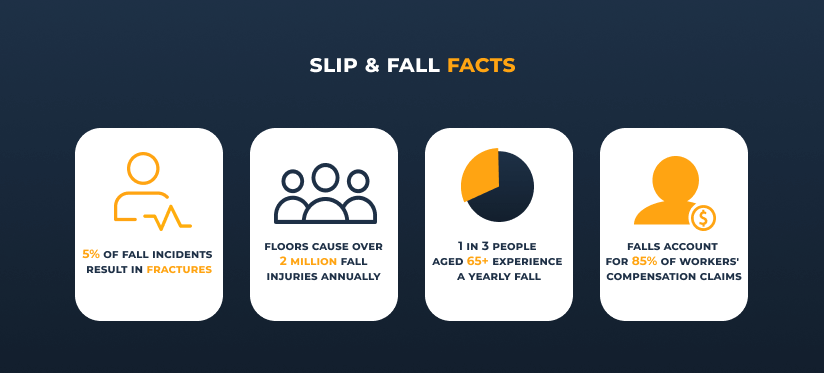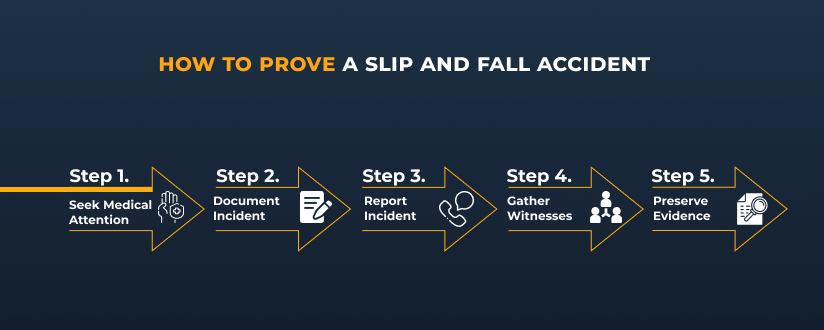
Slips and falls are a significant cause of injuries, with over 1 million emergency room visits every year. If you fall into this situation, you have all rights to receive compensation under slip and fall settlements.
In this guide, we’ll explore slip and fall lawsuits, delve into the average payment amounts and their calculation, and review some court cases. So let’s start!

A slip and fall lawsuit can arise when you seek compensation for injuries sustained due to someone else’s negligence.
This settlement is a legal agreement between the injured party (the plaintiff) and the property owner, occupier, or insurance company (the defendant). It means the defendant pays the plaintiff money to stop any more legal claims about the incident.
So, a slip and fall settlement is a way to resolve the legal dispute arising from the accident without going through a full trial. It allows both parties to avoid the time, expense, and uncertainty of court proceedings and reach an agreeable resolution.
Several factors come into play when determining the slip and fall settlements amounts. In this section, we’ll explore the key factors of slip and fall lawsuits.

The severity of the injuries sustained impacts the size of the compensation awarded. Damages resulting from slip and fall accidents can range from minor bruises to severe consequences.
Fractures are among the most serious consequences of slip and fall accidents. Statistics show that fractures happen in approximately 5% of all individuals who experience a fall. These fractures can affect various parts of the body, but one of the most on and impactful is the hip fracture.
Slip and fall accident settlements that involve fractures often result in higher compensation. Payouts cover immediate medical costs and address the long-term impact on the person’s life and financial stability.
The distinction between slip and fall settlements with surgery and without is large and influences compensation aspects. Let’s take a look.
Below are some of the signs of surgical incidents:
In cases with surgery, there is often more extensive documentation of medical expenses, expert opinions, and a focus on the injury’s long-term effects. This can lead to higher settlement amounts to cover these significant costs.
In contrast, slip, trip, and fall accidents without surgery may have a simpler negotiation process, with an emphasis on immediate medical costs and the injury’s short-term consequences.
It is important to consider all factors together, as the court considers emotional distress as an aggravating factor.

Interested in exploring more legal insights? Check out our article on ‘Bond vs Bail: Key Distinctions in the Legal Process‘.
In the realm of slip and fall settlements, the location of the incident also determines the compensation.
Premises liability and slip & fall settlements within apartments may involve property management companies, landlords, or tenants. Compensation varies depending on the extent of negligence in maintaining common areas, staircases, or walkways. Please note, that this doesn’t include cases where you slip and fall on your own property.
Parking lots, whether they belong to a retail establishment or an office complex, are common sites for slip and fall accidents. Settlements in parking lot cases may hinge on factors such as:
To report an incident, you need to know who is responsible for parking lot security.
Stores, including supermarkets, retail shops, and malls, often witness slip and fall incidents. These cases may involve issues like spills, wet floors, or cluttered aisles. Store injury settlements depend on how quickly the store addresses hazards and whether they were negligent in accident prevention.
Workplace slip and fall incidents are a significant concern, both for employees and employers. Compensation in slip and fall at work cases hinges on employer negligence, workplace safety, and injury severity.
According to the National Floor Safety Institute statistics, workplace slip and fall accidents have large economic implications ($70 billion per year). They are a major cause of occupational fatalities, especially in industries like construction and mining.
Falls are a significant cause of compensable injuries across various sectors, with around 85% of workers’ compensation claims attributed to employees slipping on slick or wet floors.
Slip and fall accidents can occur in various other locations, including nursing homes. Such incidents can have dire consequences, particularly for the elderly. Hip fractures resulting from falls in nursing homes are severe among seniors.
Falls are a leading cause of injury-related deaths among this demographic, with the risk increasing with age. Based on NFSI analysis, about 60% of fall-related incidents involve individuals aged 75 or older.
In this section, we’ll explore the calculation of slip and fall settlements, and look at a few slip and fall payouts examples.
Calculating slip and fall settlements involves an assessment of factors, including both economic and non-economic damages. Although there isn’t a fixed formula for determining the exact settlement amount, we can summarize the process as follows:

These are the quantifiable financial losses resulting from the slip and fall incident. They include:
To calculate this, add up all medical expenses and future treatment costs, lost salary (cost of sick leave and unpaid days off), and lost future income.
These are more subjective and challenging to quantify but are essential for assessing the impact of the incident. Non-economic damages may include:
There is no definite answer to how much is pain and suffering worth in a slip and fall. But, for a rough estimate, apply a multiplier of 1.5 to 5 based on injury severity. Factor in the days of pain and your daily wage to determine your compensation for pain and suffering.
A jury decides the value of non-economic damages. Your lawyer will propose the level of compensation required and provide convincing reasons why it is necessary.
Extra factors that can influence the settlement amount include:
While this formula provides a framework for the calculation of slip and fall settlements, it’s important to note that every case is unique. The specific circumstances, the severity of the injuries, and the legal nuances involved can vary. Consulting with a skilled attorney is crucial to assessing your case’s value and advocating for fair compensation based on your circumstances.

Don’t miss our article ‘Can You Get a DUI on a Bike? Navigating Legal Boundaries‘ for driving insights.
To provide a general idea of what to expect in different states, here’s an overview of the average payout for slip and fall injury in select states.
Average slip and fall settlement in California
$10,000 - $60,000
Average slip and fall settlement amounts in NJ
$15,000 - $45,000
Average slip and fall settlement in Texas
$30,000 - $50,000
Average slip and fall settlement in New York
Varies widely, from $1,000 to $1,000,000
Average slip and fall settlement amounts in Florida
$45,000 - $850,000
In states like Alabama, Maryland, the District of Columbia, Virginia, and North Carolina, if you are even 1% at fault, you cannot recover any damages. If your negligence caused the injuries, for example, if you were under the influence, your chances of winning a lawsuit and estimated settlement value are almost zero.
Please note that these figures are approximate and can vary based on individual cases.
Slipping on a wet floor is a common cause of slip and fall incidents. The compensation for such cases can range from $10,000 to $50,000 or more, depending on factors like the extent of injuries and liability.
For example, the average settlement for slip and fall knee injury is higher, starting at $ 75,000. You need to document the incident, gather evidence, and seek legal representation to secure fair compensation.
There is no average settlement figure for slip and fall incidents in stores, as the outcomes vary. But, real-life examples can shed light on the potential compensation.
For instance, Henry Walker received $7.5 million in a Walmart injury claim after accidental slipping in a store. His foot became lodged in a pallet used to display watermelons, leading to a significant injury. This case highlights that large compensation is possible when negligence is evident, and injuries are severe.
In this section, we’ll provide you with a roadmap on what to do after a slip and fall accident, and how to establish negligence in a slip and fall case.

Your actions can impact any potential legal proceedings. Here’s a step-by-step guide on what to do:
Now let’s get to the question “How long do you have to report a slip and fall?” Prompt reporting of the incident to the property owner or management is essential. This can help establish that the property owner had notice of the hazardous condition.
The slip and fall statute of limitations can differ from state to state and ranges from 2 to 4 years.
In any case, contact a slip and fall attorney as soon as possible. They can provide guidance, assess the strength of your case, and help you navigate the legal process.

Read also “What Proof Do You Need for a Restraining Order? A Quick Guide” for more details on the court process.
To succeed in a slip and fall case, you must establish negligence on the part of the property owner or occupier. Here’s what you need to prove:
Be prepared to address any claims of comparative negligence, which means both you and the property owner share some degree of fault. A court may adjust your compensation based on your level of responsibility.
Slip and fall settlements are a means of obtaining compensation for injuries sustained due to the negligence of others. But, the legal landscape is complex, and seeking professional guidance is often necessary.
If you or a loved one has experienced a slip and fall incident, we encourage you to contact us to find an experienced slip and fall lawyer. We will guide you to seek assistance to navigate the legal process and get the compensation you deserve.
The highest payout on record exceeded the million dollar slip and fall settlements mark. In a notable case, Marcus Gustafsson received an $18 million settlement when he slipped and fell 20 feet through an open manhole, resulting in severe injuries, including a broken back.
Yes, many slip and fall cases settle out of court through negotiation. They often resolve with a fair settlement agreement, unless it is a fatal incident or manslaughter.
Gather evidence, report the incident to the property owner or manager, and consult a slip and fall attorney who specializes in how to settle a slip and fall claim.
If authorities settle the claim in your favor, compensation takes between 2 weeks and a month to pay out. The timeframe accounts for necessary paperwork processing and payment issuance.










